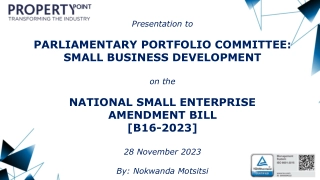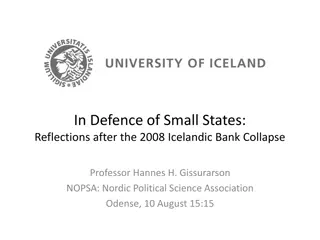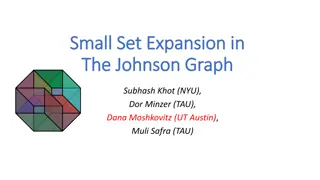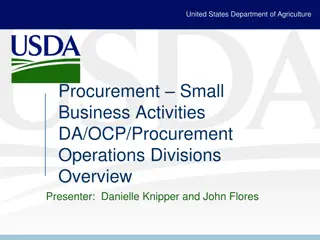
Robust Estimators for PT Scheme Analysis
Explore methods for determining assigned values and uncertainties in PT schemes with a small number of participants as per ISO 13528:2022. Learn about using robust estimators like Algorithm A and nIQR method, handling outliers, and ensuring accurate results even with limited participant data.
Download Presentation

Please find below an Image/Link to download the presentation.
The content on the website is provided AS IS for your information and personal use only. It may not be sold, licensed, or shared on other websites without obtaining consent from the author. If you encounter any issues during the download, it is possible that the publisher has removed the file from their server.
You are allowed to download the files provided on this website for personal or commercial use, subject to the condition that they are used lawfully. All files are the property of their respective owners.
The content on the website is provided AS IS for your information and personal use only. It may not be sold, licensed, or shared on other websites without obtaining consent from the author.
E N D
Presentation Transcript
PT statistics for small number of participants (Annex D of ISO 13528) S.SUBRAMANIAN 6/26/2025 S.SUBRAMANIAN 1
When the number of participants p is less Assigned Value (and its uncertainty) and/or SDPA should be determined independent of the participants. Possible methods for determination of Assigned Value and its uncertainty, as specified in clauses 7.3, 7.4, 7.5, or 7.6 of ISO 13528:2022 : a) b) By using a CRM as PT item - clause 7.4; c) By characterizing the PT item using a valid CRM in one laboratory (also called as Value transfer from a CRM to a closely matched candidate RM) - clause 7.5; d) Using consensus value from expert laboratories (which are not participants in the PT Scheme) - clause 7.6 By formulation (Known Value Scheme) clause 7.3; 2 6/26/2025 S.SUBRAMANIAN
Possible methods for determination of Assigned Value and its uncertainty, as specified in clauses 8.2, 8.3, 8.4, or 8.5 of ISO 13528:2022 : a) By perception of experts - clause 8.2; b) By experience from previous rounds of a PT Scheme - clause 8.3; c) By using Horwitz formula (applicable to analytical PT Schemes) - clause 8.4; d) By using Reproducibility and/or Repeatability SD (as given in the standard test method) - clause 8.5. By using this approach (determination of Assigned Value as well as SDPA independent of participants) PT Schemes can be conducted even with one participant . 3 6/26/2025 S.SUBRAMANIAN
What to do when assigned value (and its uncertainty) can t be determined independent of participants? (e.g) Mechanical testing of textiles, leather etc., for tensile strength, GSM, Tear strength, Abrasion resistance etc., for which suitable CRMs are not available Chemical testing of many products including textiles, (Shrinkage, Blend composition, Colour Fastness to laundering, dry cleaning, light, etc.,) Only consensus value from the participants results can be used in such PT schemes. 4 6/26/2025 S.SUBRAMANIAN
Robust estimators such as Algorithm A and nIQR method are used for the determination of both assigned value as well as SDPA while using consensus value from the participants results. But, use of robust estimators are acceptable only when the number of participants (after removal of outliers) is 12. In this case, the approach as specified in Annex D of ISO 13528:2022 can be used 5 6/26/2025 S.SUBRAMANIAN
Annex D approach when p is < 12 Step 1: Identify outliers (blunders) in the participants results and remove them for determination of Assigned Value (and its uncertainty) as well as SDPA. Step 2: Determine Assigned Value and its uncertainty from the participants results. Step 3: Determine SDPA independent of participants, as given in clauses 8.2, 8.3, 8.4 or 8.5 of ISO 13528:2022. Alternatively, determine SDPA from the participants results using formula given below. Step 4: Ensure that the performance of (outliers/ blunders) identified as per step-1 is not satisfactory. If it is not so, don t consider such result as blunder and go to step-2. 6 6/26/2025 S.SUBRAMANIAN
Annex D approach when p is < 12 Step 1: Identify outliers in the participants results and remove them for determination of Assigned Value (and its uncertainty) as well as SDPA. Grubbs test Using median & MPE Results with Z/Z score 5 and below or 5 and above 7 6/26/2025 S.SUBRAMANIAN
Annex D approach when p is < 12 Step 2: Determine Assigned Value and its uncertainty from the participants results. Take the median of the participants results after removal of blunders as the Assigned Value. Also calculate standard deviation (SD)of the participants results. Calculate the Standard Uncertainty in the assigned value, SU using the following formula: SU = SD/ p This method is valid only when the assigned value is validated by comparing the median of small number of participants with an independent reference value (such as homogeneity average value) as per clause 7.8 of ISO 13528:2022. 8 6/26/2025 S.SUBRAMANIAN
Annex D approach when p is < 12 Step 3: Determine SDPA independent of participants, as given in clauses 8.2, 8.3, 8.4 or 8.5 of ISO 13528:2022. Alternatively, determine SDPA from the participants results using formula given below. Sum of absolute difference between each result and MEDIAN SDPA = (0.798 x p) This method is valid only when Lower and Upper limit are stipulated for the SDPA determined from the participants results in accordance with Clause 8.6.2.1 and 8.6.2.2 of ISO 13528:2022. 9 6/26/2025 S.SUBRAMANIAN
Annex D approach when p is < 12 Step 4: Ensure that the performance of (outliers/ blunders) identified as per step-1 is not satisfactory. If it is not so, don t consider such result as blunder and go to step-2. i.e Do not consider such a result as blunder which is identified earlier as a blunder by Grubbs test or other means, but performance is not unsatisfactory . Recalculate both assigned value as well as SDPA by including the lab result which was originally identified as blunder. 10 6/26/2025 S.SUBRAMANIAN
Annex D approach when p is < 12 SDPA determined using formula given in Annex D Code LAB-08 LAB-07 LAB-11 LAB-13 LAB-09 LAB-12 LAB-14 LAB-05 LAB-04 LAB-01 Value 240 267 269 270 272 274 295 300 314 341 273.00 10 Deviation 33.00 6.00 4.00 3.00 1.00 1.00 22.00 27.00 41.39 68.00 Z' Score -1.22 -0.22 -0.15 -0.11 -0.04 0.04 0.81 1.00 1.53 2.51 Assigned Value p AV= SD= SU= 273.00 25.8634 8.1787 0.3 x SD= 7.7590 S.SUBRAMANIAN 6/26/2025 11
Annex D approach when p is < 12 SDPA determined by perception Clause 8.2 Code EO_01 EO_13 EO_28 EO_14 Value 60.1 79.8 84.2 90.5 Deviation Z' (from Deviation) 21.90 2.20 2.20 8.50 Z' @ 10% -2.22 -0.22 0.22 0.86 -1.80 -0.18 0.18 0.70 82.00 4 Assigned Value p AV= SD= SU= 82.00 10.902 5.451 13.295% 8.20 2.460 0.3 x SD= 12 6/26/2025 S.SUBRAMANIAN






















